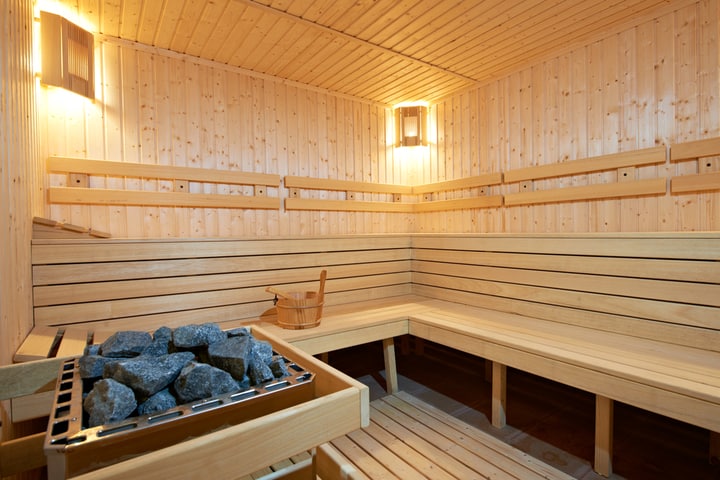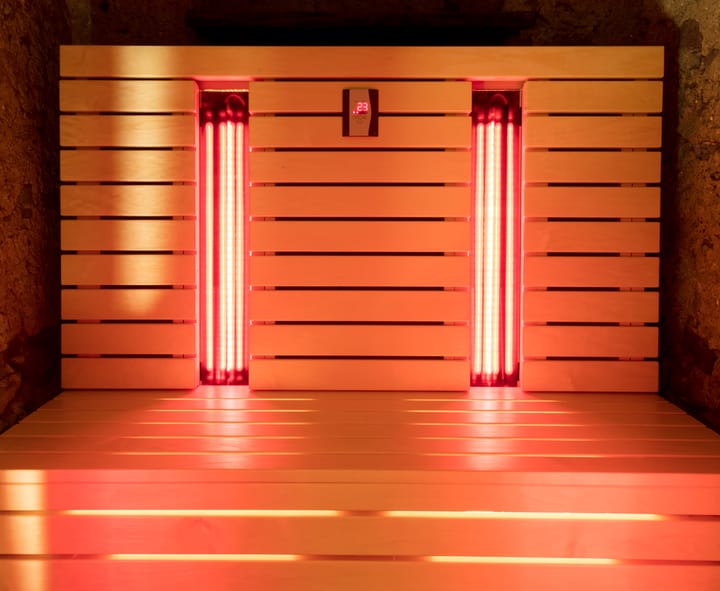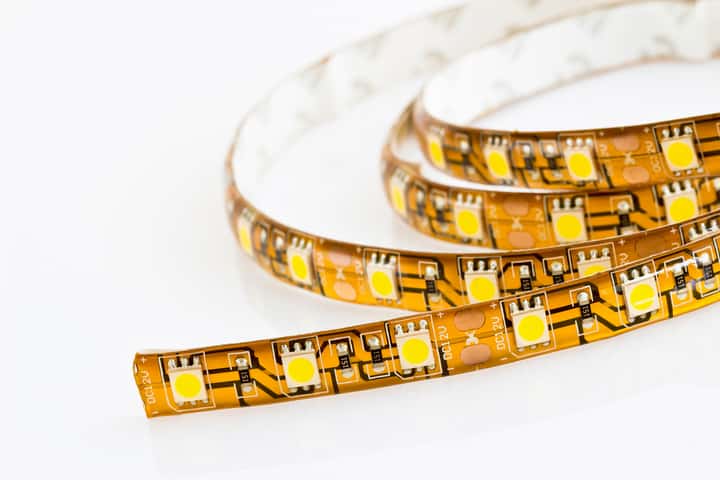Saunas have many health benefits for you – high temperatures encourage you to sweat, improve circulation and relax muscles, making them great to use around a healthy exercise lifestyle to improve your recovery.
However, because you’re sitting in a room with a high temperature, you want to be as comfortable as possible, and that includes making sure the sauna is well-lit. If you’re hot, you don’t want to be squinting in poor light.
So with that in mind, are LEDs a good idea for illuminating your sauna?
LED lights are good for infrared saunas, which reach lower temperatures, but they aren’t recommended for traditional saunas as they get too hot and damage the bulb. For steam rooms, LEDs should ideally be IP68 rated to keep them safe from the vapor.
In this article I’ll explain in more detail:
- Why traditional saunas aren’t suited to saunas
- The difference with infrared saunas
- What to consider with steam rooms and LED bulbs
Will High Temperatures In The Sauna Damage An LED Bulb?

Let’s state the obvious. LED light bulbs hate high temperatures.
They’re efficient when they’re working in a junction temperature range between around 100°F and 140°F, but are most efficient when in a cooler environment.
Once the ambient temperature starts getting above that 140-degree level, the bulb’s lifespan will begin to decrease.
That’s because the semiconductor will start to degrade at a faster rate with more heat.
Whereas a typical LED bulb can last for up to 50,000 hours or so, as soon as it is exposed to temperatures above 140°F, that will reduce.
So how hot does a sauna get?
The Finnish Sauna Society are the experts and they recommend a temperature between 80 and 100 degrees Celsius, which is the equivalent of 176 to 212 degrees Fahrenheit.
Immediately it’s clear that a sauna is not the best place to use LED bulbs. One of the main benefits of LEDs is their extended lifespan, but you’re negating that with the higher temperatures of saunas.
What’s the alternative?
Well, for a traditional sauna, it might be best to stick with older incandescent bulbs. Incandescent bulbs themselves give off a lot of heat – they’re highly inefficient, with around 90% of the energy generated being heat and only 10% light.
However, that does mean they aren’t impacted by the ambient temperature of a sauna in the same way that LEDs are.
Incandescent bulbs themselves can reach temperatures of around 500 degrees Fahrenheit on the glass body – way higher than even the sauna temperature.
With LED bulbs costing more than incandescent options, you might wish to stick to the older, less efficient option for your sauna, since you’ll need to replace LEDs more frequently as they burn out.
Can I Use an LED Bulb In An Infrared Sauna?

Infrared saunas are a slightly different proposition because they are designed to be smaller and don’t reach high temperatures.
An infrared sauna is usually heated to between 120°F and 140°F, so at the maximum level of the sauna, they won’t be impacting the lifespan of the LED.
The LED might not be as effective when it’s at a temperature at that level, but you may be happier with a dimmer light that lasts longer, particularly if it’s a smaller one-person sauna.
The one thing to consider is whether infrared lights can damage the LED light bulbs.
Infrared light does generate heat when it contacts a surface, but in any sauna, the infrared bulbs will be positioned away from the lighting so that they only reach the user.
If the infrared was pointed directly at your lighting, you would be heating the bulb, which would damage it and cause the lifespan to drop.
But in infrared saunas, the heat emitters are either adjacent to the lights in the top of the sauna, pointing down, or they’re in the side and are directed horizontally.
The lights in the ceiling of the sauna will be fine.
So, you can use LED lights in infrared saunas, without the impact on the lifespan of the bulb, providing it is within the temperatures mentioned above.
LED Strip Lights and Saunas

Strip lights are another popular LED lighting solution – and they can really enhance the look of a sauna too.
So are LED strip lights any different from a regular LED bulb when it comes to heat resistance?
Generally, they’re the same. You need to have the same considerations for LED strip lights that you would do with a bulb because they will overheat and reduce their lifespan.
Strip lights can sometimes feel hotter than an LED bulb, which might make you think they’re used to working in higher temperatures, but that’s just because with a bulb, you’d normally handle the resin casing rather than the base.
The actual LED part is still heating up, and a strip is just a series of these LEDs in close proximity and more exposed.
However you can find LED strip lights that are specially designed to be used in saunas.
They’re painted with a coating that acts as an additional heat barrier and coolant, protecting the bulbs at higher temperatures.
As for installing, I would recommend positioning the light closer to the ground as it has a cooler temperature because the hot steam or air rises up.
Avoid installing the strip lights on the wood as it is a poor heat conductor. Ideally place strip lights directly on concrete or aluminum bars as they offer a better heat dissipation.
Note that aluminum also gets heated in the sauna, which at the end can do more harm so the ideal solution would be to install them on concrete walls close to the ground.
Can Humidity In The Steam Room Damage LEDs?

In a steam room, water is heated to generate a lot of steam – which means the air is extremely humid.
They can feel as hot as a sauna, but a lot of that is down to the humidity of the air – steam rooms generally reach a maximum of 110°F.
But just because the temperature is in a safe range, that doesn’t mean you don’t need to be careful when using LED bulbs in a steam room.
If the bulbs are penetrated by the humid air, the water will corrode the internal elements and could be dangerous too when it comes to changing the bulb.
That doesn’t mean that LED lights are a complete no-no for steam rooms or for saunas where you’re going to keep the humidity high.
It just means you need to make sure you buy the right level of the waterproof bulb to ensure they stay safe.
For this, you need to refer to the Ingress Protection code or the IP rating. The IP rating tells you how waterproof a bulb (or any electrical item) is.
The code is pretty straightforward. It’s made up of two digits. The first is for solid particles and is scored from 0 to 6. If an IP rating starts with IP0, then it has absolutely no protection.
If it’s IP6, it is completely dust-proof – no solid particles can get in or out.
Light bulbs should all be IP6 to protect them and prevent dust from catching fire.
The second digit matters a little more, is related to liquids, and ranged from 0-9. You might get some light bulbs for indoor use, which are IP64, protected against splashing water, or IP65, protected against water jets.
Outdoor lights will be IP66 to make sure they’re protected against sustained heavy rain.
That’s not quite enough for a steam room, though – the pressure that steam causes, combined with the constant presence of vapor in the air, means that you need to aim a little higher.
IP68 is what you need to buy if you want to use LED lights in a steam room or any humid setting with pressured steam.
Final Words
You need to be very careful using LED lights in a sauna or steam room. Traditional Finnish saunas are too hot for an LED to work effectively, but an infrared sauna tends to be more manageable.
And always check the waterproof rating of any bulbs you buy for a steam room – you don’t need me to tell you that water and electricity don’t mix, and steam is like high-pressure water – a dangerous combination.
Have you bought or built a sauna, and which lights did you choose? Or have you had any other interesting facilities where you’ve had to carefully plan your lighting solution?
Let me know in the comments.
Looking for an LED bulb but not sure what type you need?
Check out my free bulb picker and select the right bulb within few clicks.

